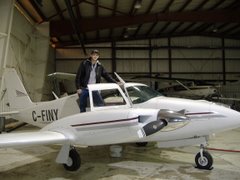Recently we've been working on a couple retractable gear single engine airplanes in the shop. We just did an annual on a Cessna 182 RG, and then just the other day a Cessna 177 Cardinal RG came in with some minor problems. I have always thought that the Cessna Cardinal was the coolest single engine Cessna ever built. Its just a slick airplane. The high wing on it is of the fully cantilevered design, meaning there are no unsightly and cumbersome struts extending out from the airplane. This feature, combined with the fact that the landing gear is slightly aft of the door makes it the easiest airplane ever to get into. It is just like getting into a car. Open the door and get in. There's no step up, climbing onto the wing, and tripping over the landing gear or wing struts. The retractable versions are fairly quick as well. The Cardinal was Cessna's competition to Piper's Arrow.
Anyways seeing all these retractable singles coming through gets me thinking about what the conventions of flying them would be, specifically, when would be the best time to retract the landing gear? I've never flown a retractable single before, so any pilots reading this who have, I'd been interested to hear your opinions.
When flying a multi-engine aircraft, we retract the landing gear once we've committed to the takeoff, or in the case of a jet where the decision to continue the takeoff (V1) is made while still on the ground, they'd retract the gear once a positive rate of climb has been developed. In a single, there's no such decision to be made. If the one engine continues operating, we continue with the takeoff, if it decides to quit at any time, there's no ifs ands or buts about it - we're going to land. So I suppose the considerations that should be made are:
1) The aircraft will climb better with the landing gear retracted.
2) A landing in the event of an engine failure is generally more survivable with the landing gear extended, whether off airport or on airport.
Keeping these in mind, what makes the most sense to me, is to make the initial climbout with the landing gear extended until you reach a height great enough to allow enough gliding time for the gear to be extended again if you have an engine failure after you rectract them. After you retract the gear it should be a priority to climb as fast as possible to reach a safe altitude.
It is important to note however that landing gear may operate differently with an engine failed, depending on the system. There are three different types of landing gear systems: Fully hydraulic, electric-hydraulic, and fully electric. Fully hydraulic, more common on multi-engine aircraft, this system uses an engine driven pump to power the hydraulic system of the landing gear. An electric-hydraulic system uses an electric motor to power the hydraulic system. A fully electric system, like in the Twin Comanche, uses an electric motor to mechanically operate the landing gear using levers and gears.
It is easy to understand that with a fully hydraulic system, the hydraulic system will stop working if the engine powering it stops working. This is generally not a problem with twins, because they'd normally be equipped with a hydraulic pump on both engines, but if this system is installed on a single, and the engine fails, you're going to have to use the alternate means of extending the landing gear, which would normally be a hydraulic hand pump.
Now I can't actually think of any single engine retractable aircraft that has a fully hydraulic landing gear system, that would be stupid. Most of them have either electric or electric-hydraulic for this reason. I thought it would be interesting to mention however, that the time that should be allowed after takeoff to extend the gear again, should be the time it takes for the landing gear to be extended with the engine failed.
I'd be interested to hear others opinions, because I've been watching these retractable singles taking off, and almost all of them retract the gear immediately after lift-off. I can't help but want to ask them, what would happen if an engine failure occurred immediately after you retract the gear? The result would likely be a belly landing on the runway... an unfortunate and very preventable mishap.
Subscribe to:
Post Comments (Atom)




I'm a partner in a Cardinal RG and love it. It's way better than an Arrow IMHO. I can't think of single advantage to an Arrow.
ReplyDeleteMooneys are much faster and get better mileage, but they are so very much smaller than the Cardinal.
"It is easy to understand that with a fully hydraulic system, the hydraulic system will stop working if the engine powering it stops working."
In the Cardinal and Cutlass the hydraulics are powered by an electric pump, so you have pressure as long as you have electricity.
I agree with you about the Mooneys. I've sat in them before and they are far too small for my liking, almost worse then a Cessna 150 because there's less head room. Very pretty airplanes though.
ReplyDelete